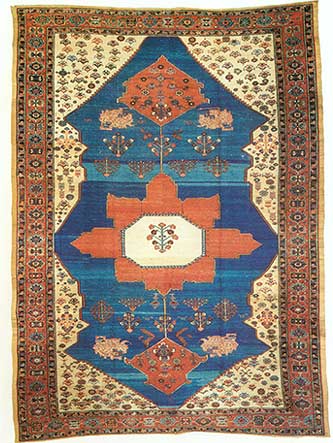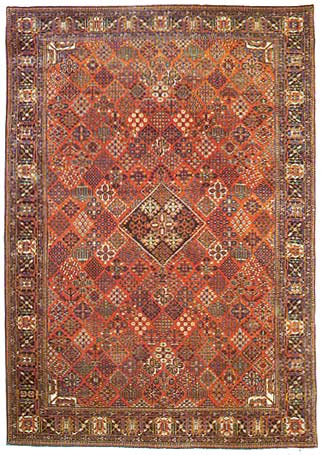RUG GUIDE
THE ILLUSTRATED RUG - the Rugs of PersiaIRAN (Persia) Known as the original home of the Oriental carpet, Iran (Persia) the oldest and once the most powerful empire in the Middle East, stood at the crossroads of Eastern and Western civilizations. Under the Safavid dynasty (1502-1736), Iran attained its artistic height, and court weaving, together with the art of calligraphy, miniature painting, and tilework, flourished to exceptional heights. This brilliant era witnessed the development of highly qualified carpet factories in cities including Kerman, Isfahan, Kashan, Tabriz, and Herat (now a part of Afghanistan). Iran is the genesis of most motifs, patterns, and traditional colorations produced in rugs throughout the world today. Over the centuries, Persian carpets have become treasured heirlooms passed on from one generation to the next. By the mid-19th century, American, British, and German firms had established new carpet production facilities in Meshed, Tabriz, Kerman, and Sultanabad (now Arak), thus ensuring the art form's continued development. And in the 20th century, under Shah Reza Pahlavi, royal factories were established to utilize only the finest materials and methods of manufacture. Oriental rugs have always been and are still an intrinsic part of Iranian culture and its people's daily lives. Indeed, Oriental rugs are in many cases their most valued possession and are an integral part of their home furnishings. Thus, it is not surprising that current production levels throughout Iran equal if not surpass those reached prior to the Islamic Revolution of 1979. In fact, rugs are now even produced in areas where weaving was heretofore not practiced. Furthermore, Persian carpets continue to boast very high quality standards and command a very brisk interest in domestic and international markets. While large city workshops were an important factor in the past, much of today's production is fashioned along cottage industry lines in smaller villages and towns.
Persian carpets are traditionally known for their tremendous variety in design, color, size, and weave, and for the uniqueness of each and every rug produced. Rugs are generally named after the village, town, or district where they are woven or collected, or by the weaving tribe in the case of nomadic pieces. Each rug's particular pattern, palette, and weave are uniquely linked with the indigenous culture, and weaving techniques are specific to an identifiable geographic area or nomadic tribe. Such is the case, for instance, of the richly colored Bakhtiari rugs - frequently characterized by ellipse-shaped medallions with floral patterns - woven by the Bakhtiari nomads and villagers of southern Iran. Generally smaller in size, Persian nomadic, village, and flat-woven rugs (e.g., kilims) are broadly characterized by traditional angular designs and bold as well as somber colors. Typical is the south Persian Qashqai, often finely woven and featuring a diamond-shaped medallion on a detailed background of geometric or stylized flowers. Predominant colors include reddish browns and blues. Other nomadic and village types include the Bakhtiari, Hamadan, Shiraz, Kurd, and Karaja. Meanwhile, the more sophisticated carpets originating from the historic cities of Tabriz, Kashan, Kerman, Nain, and Qum feature finely woven floral patterns and complex curvilinear motifs. More elaborate pieces are often pictorial in design and depict hunting scenes, men in combat, landscapes, and historic folklore figures. Persian carpets offer a full gamut of colorations from the pastel shades of champagne, rose, and green, typical of a Kerman for instance, to the striking reds and blues of a Heriz. This highly popular pattern is characterized by a bold and angular medallion and corner design. Just as with design, Persian color ways are a continued source of inspiration for other rug-producing countries throughout the world.
The Fine Art of Persian Carpet WeavingSamples from the 16th - 19th Centuries From recorded history the carpets of the near east were renowned for their splendor and magnificence - Persian carpets in particular. Indeed, and perhaps not surprisingly, the oldest known rug is from Persia, and as early as the 6th Century the Persian carpet had attained prestige enough, according to the Sui annals ( Sui-su, Laufer, Sino-Iranica ), to have been commercially exported to places as far distant as China. Also, it is acknowledged that Persian carpet weavers, by this time had already achieved some variety with regard to both technique and materials: wool or silk - either pile or tapestry woven, embroidered, or even of shuttle-woven silk ( Pope, A Survey of Persian Art ). 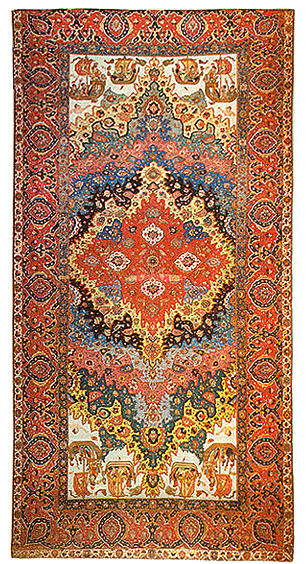
Classical Persian Royal Carpet with Large Center Medallion 18th century (Persia) It could be observed that carpet weaving, or at least it's proliferation and elevation to a high art form, was, for the most part, a kingly concern and invention, and one not necessarily limited to (i.e. France) near eastern lands. As can be observed centuries later in France (and the court at Versailles), as in Persia, control of artistic as well as the productive concerns with regards to both the making of and the use and enjoyment of carpets and tapestry weavings began with, and was the exclusive domain of, royalty. Moreover certain types, large and/or exotic carpets especially, were reserved for court use, and so costly that they were considered important items in the royal treasury - carpets of stunning grandeur that often used silk instead of, or in addition to, wool and genuine silver and gold thread and/or semiprecious jewels: it has been reported that the Caliph Harun al-Rashid had no less than 22,000 fine rugs adorning his palace. 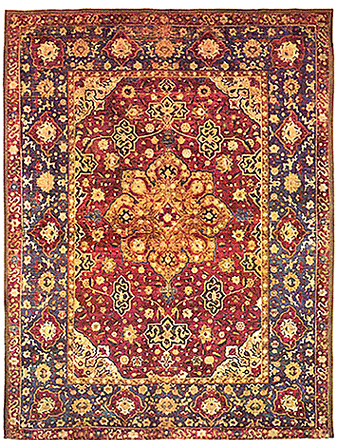 16th Century Silk with Medallion (Persia) The carpets of royalty were generally of the "medallion" type, characterized by complex arabesque designs around a central motif, and sometimes extending over 25 feet in length. Under the direction of a salim (foreman), who chanted instructions as to color sequences etc., the Muslim carpetmaker could painstakingly tie up to 900 knots an hour, with an average weave or knot density of 320 knots to the square inch. Peter the Great, wealthy Czar of Russia, is known to have given the Royal House of Hapsburg, in Austria, a silk medallion Persian carpet of 783 knots per square inch that took several years to weave. 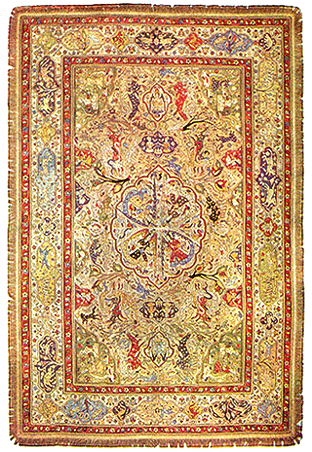
17th Century Woven Silk (Persia) The devastation of the 13th century Mongol invasion certainly depressed the artistic and cultural pursuits of most of Persia, this situation only partially remediated by the architectural and artistic achievements of the Ilkhan renaissance (1290-1355). The bloody conquests of Tamerlane were disastrous to Persia, however, under his rule favoured artisans were spared, and were removed in large numbers to work on his great palaces in Turkistan, particularly at Samarkand and Bukhara, where they were chiefly responsible for a new school of decorative art and design. 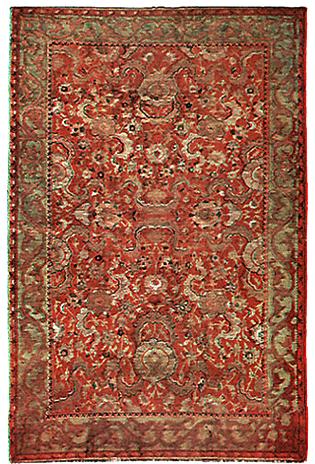
17th Century Brocaded Silk (Persia) Out of this, under the enlightened and cultivated rule of Tamerlane's successors, particularly Shah Rukh (1377-1447) and Baizangur (1396-1433), literature and the arts flourished - and especially the fine art of rug weaving which would reach its zenith in the magnificent Persia carpet of the 16th century. Like most of the finest art of the times, these carpets were produced in palace ateliers on court-subsidized looms - thus making for unity and integrity of style. Meanwhile a sensitive yet exacting clientele imposed the highest standards - such lavish royal support insuring masterful technical proficiency as well as the provision of the most suitable raw materials. All these conditions and advantages were provided under the Timurids through the 15th century and under the Safavids. 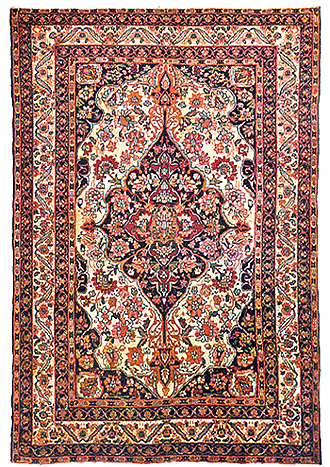
19th Century Silk Kerman (Persia) Beautiful rug design was, to varying degree, appropriated by other arts - the illuminator given authority over the weaver, who was relegated to the role of mere assistant. However such domination by gifted artists accounts in no small measure for the special character of the court carpets of the period: the variety of color, the ingenuity and imaginative range of pattern schemes, the lucid and expressive, yet precise, draftsmanship - elevating these products to a rank equivalent to that of great classical painting. Remarkably, John Singer Sargent, as well as Sir Charles Holmes, had both on separate occasions, and referring to different 16th century carpets, made the following emphatic point of comparison: "There is more art in a really great carpet than in any picture ever painted!" 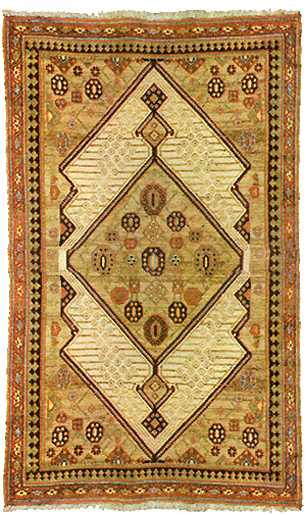
19th Century Hamadan (Persia) By the 15th and 16th centuries Persian carpets began to be incorporated into the paintings of prominent European artists, many of whom also owned them, and Van Dyke and Breughel, in particular, rendered them with such complete fidelity that these carpets can be accurately identified with respect to production details. Other depictions by Flemish artists i.e. Memling, Van Eyck, Cristus render the carpet detail so carefully that even the individual knots are sometimes visible. 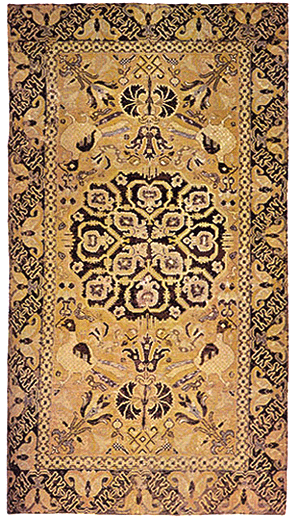
18th Century Hamadan (Persia) It has been accepted practice to name the great court carpets of the 16th century in accordance with apparent motifs that appear in the artwork itself, irrespective of region perhaps i.e.: Hunting carpets, Garden carpets, Medallion carpets, Vase carpets, and of course Prayer carpets. By the 19th century the principal weaving centers in Persia were Tabriz in the northwest, Joshaghan in central Persia, Kerman and Ravar in the southeast, Meshed in the northeast, the Sultanabad district in Western Persia, and Kashan - noted for its fine textiles as early as the 12th cehtury. These centers have all woven large carpets, Meshed, Kerman and Tabriz utilizing the medallion schemes of early classical time, Joshaghan and some Kerman carpets repeating various interpretations of the garden motive. 
17th Century Vase Carpet (Persia) Major Carpet Weaving Centers of Persia
Introduction |
The Illustrated Rug - Part 2 |
The Illustrated Rug - Part 3 |
Rugs of Afghanistan |


